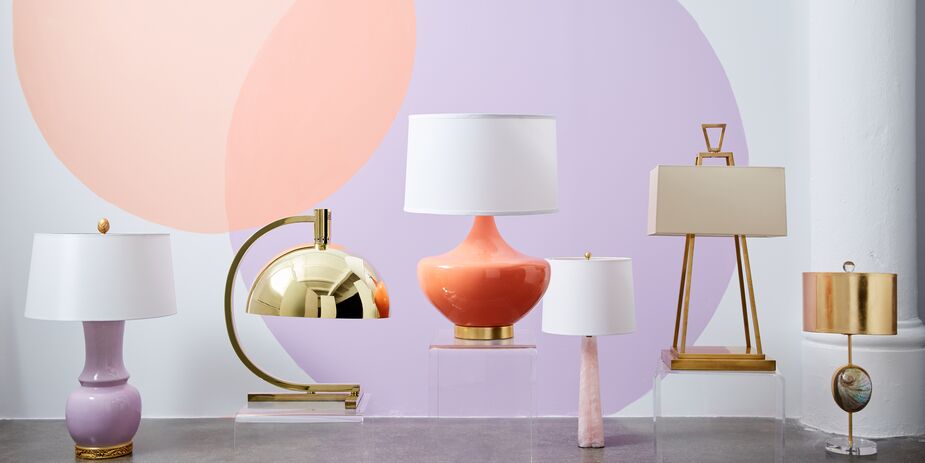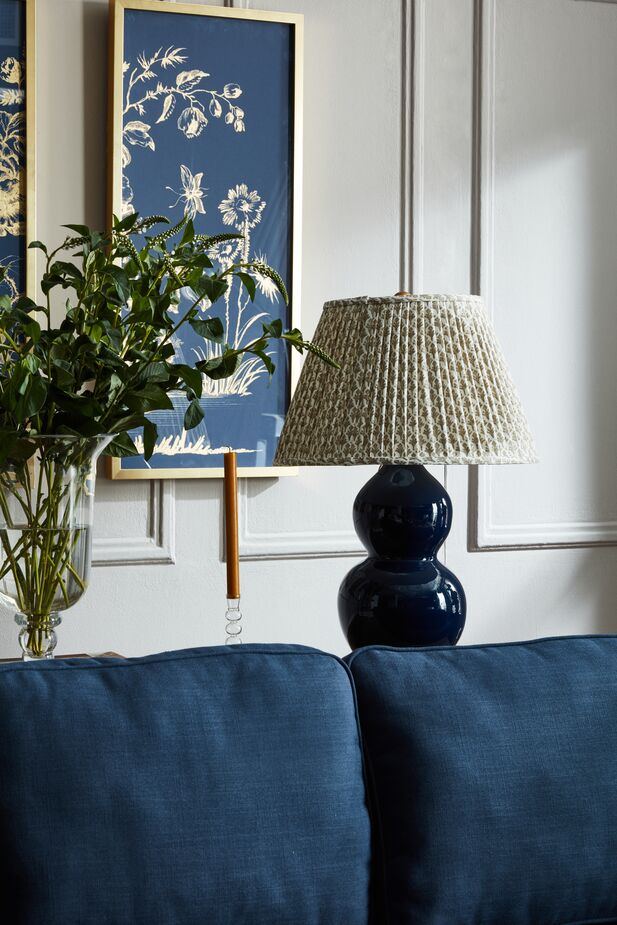Table lamps are small but mighty. The right lamp brightens a room both literally and figuratively. A less-than-optimal lamp can be an eyesore as well as leave your eyes sore as you strive to work or read amid inadequate light.
To help you choose a table lamp that shines light where you need and enhances a room whether it’s on or off, we’ve gathered the following suggestions.

The slender body of the Byrant Table Lamp leaves enough space on the top of this nightstand for a catchall, glasses, and other bedside essentials. Find the cane wingback bed here and the Matouk Schumacher Collection bedding here.
• First things first: Determine the optimal height. A rule of thumb is that the bottom of the lampshade should be approximately eye level with the person sitting nearest it. If the shade falls much lower, the lamp won’t provide enough illumination; if it’s much higher, the glare of a naked bulb will hit the person. So before buying a lamp for your nightstand or end table, sit down and measure the height between the tabletop and your sightline. Let’s say that distance is 18 inches. A 28-inch-high lamp with a shade that’s 10 inches from top to bottom would work; ditto a 25-inch-high lamp with a shade that’s about 7 inches in height.
• Aim to have the tops of all the lamps in the room roughly the same height. Too much disparity in height can be visually jarring.
• Keep the lamp’s circumference in mind too. The table lamp has to fit on the table, of course. Ideally even the lampshade should not extend beyond the tabletop—not just for aesthetics but because a lamp that approaches the edges of a table is more easily knocked over. Beyond that, consider what else you’ll be placing on the table. If you intend to rest a cup, a book, and eyeglasses on the table, make certain your lamp is slender enough to accommodate all that.
• Determine the lamp’s purpose. There are two basic types of room lighting. Task lighting is exactly that: It helps you perform specific tasks, such as reading or sewing. Ambient lighting is more general, such as recessed ceiling lighting that brightens an entire living room. If your table lamp is going to serve as ambient light—a buffet lamp in the dining room, say—you can opt for a lower wattage.

A pair of matching table lamps, such as the Emmy Table Lamps in Celadon seen here, give a pleasing symmetry to a vignette.
• Factor in flexibility. A dimmer switch gives you control over a table lamp’s brightness. Alternatively, consider a two-bulb lamp with two pulls so that you can turn on either or both bulbs, or a lamp with a three-way switch that, in conjunction with a three-way bulb, enables you to choose low, medium, or high brightness. And especially for task lighting, you might want a swing-arm lamp, a gooseneck lamp, or one that allows you to adjust the direction of the shade.
• Think about the shape and color of the shade. The narrower the bottom of the lampshade, the smaller the area that will be illuminated—but the light in that area will be brighter than if the lampshade were broader. So for ambient lighting, an empire or bell shade, with a bottom that’s broader than the top, is great. For task lighting, though, you might prefer a narrow drum shade. And while you might think a pale or translucent shade allows for optimal illumination, for task lighting a dark or opaque shade might be best, as it would reduce the diffusion of light, focusing it on one smaller area.
• Consider proportion when swapping out a lampshade. Most table lamps come with a shade in a complementary shape and size, but you’re certainly not beholden to use that shade. When selecting a new shade, look for one that’s roughly two-thirds the height of the lamp itself and about twice the width of the lamp. So for a lamp that’s 25 inches from base to finial, consider shades that are 16 to 18 inches high; for a lamp that’s 15 inches in diameter, look for shades 28 to 32 inches wide.

You can move the shade of the Penelope Task Lamp up and down. That, along with its compact size, makes it ideal for a desk. Find the desk here and the rug here. Photo by Joe Schmelzer.


Join the Discussion